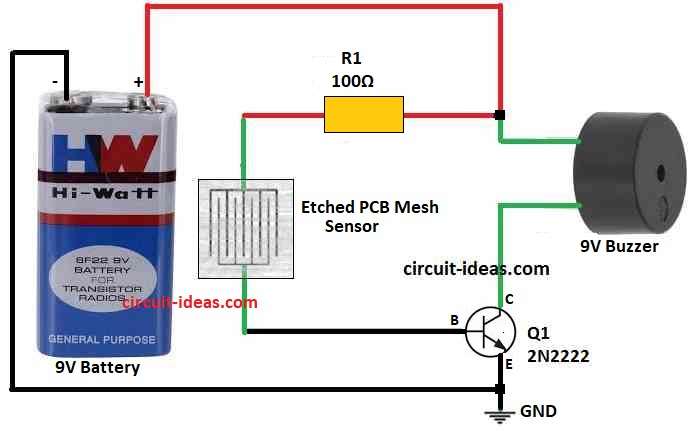This Simple Rain Detector Alarm Circuit will help from getting our clothes wet from the sudden rain.
It show how to make a easy rain detector alarm circuit.
This circuit uses sensor to know when it is going to rain and then it make sound to give warning.
So we can take umbrella or bring things inside.
Same type of this circuit are also used in car alarm and garden sprinkler.
Here we tell how to make simple rain alarm with few parts only.
Working Principle:
To make this easy and cheap circuit wee need small idea about electronic parts and how circuit work.
Main job of this circuit is to make sound alarm when it feel like rain.
Below we will show how this circuit work:
Circuit Working:

Parts List:
| Component | Value | Qty |
| Resistor | 100Ω 1/4 watt | 1 |
| Semiconductors | Transistor 2N2222 | 1 |
| Buzzer 9V | 1 | |
| Rain Sensor Etched PCB Mesh | 1 | |
| Battery 9V PP3 | 1 |
To start the circuit a small voltage connects to base of 2N2222 transistor.
Rain sensor is made using one wire and Vero board which do main work.
When rain drop touch the sensor the transistor start working.
If rainwater is found Q1 transistor 2N2222 allow current to pass.
If there is no rain then transistor base stay OFF so no current flow.
But when rain come and touches sensor then alarm turn ON and make sound.
Formula:
How Transistor Work in This Circuit using ohms law:
When transistor turn ON in rain alarm we can show it by this formula:
I = V / R
where:
- I is current going through transistor 2N2222
- V is voltage at transistor base
- R is resistance of transistor and rain sensor together
Good and Bad Points:
Good Points:
- This type of circuit is cheap and easy to make
- It give sound warning when rain come and so we stay safe
Bad Points:
- It works only for rain not for other weather like wind or snow
- This simple circuit is not good for big or smart systems
Application and Uses:
Where We Can Use This Simple Rain Alarm Circuit:
- Farmers can use it to know when rain will start so they can control water for crops.
- Can help save water if we make the circuit better.
- In smart homes this circuit can help close windows or move roof when rain come to protect house.
- In cars it can turn ON wipers when rain or water falls on glass and this will help driver see better in bad weather.
Conclusion:
Easy way to get rain warning on time and avoid surprise problems is by using Simple Rain Detector Alarm Circuit.
This small circuit is helpful in many places like smart homes, farms and cars.
Anyone can make it but just need little knowledge of electronics.
This rain alarm circuit can make life better whether anyone is a farmer, house owner or person who love cars.
Leave a Reply